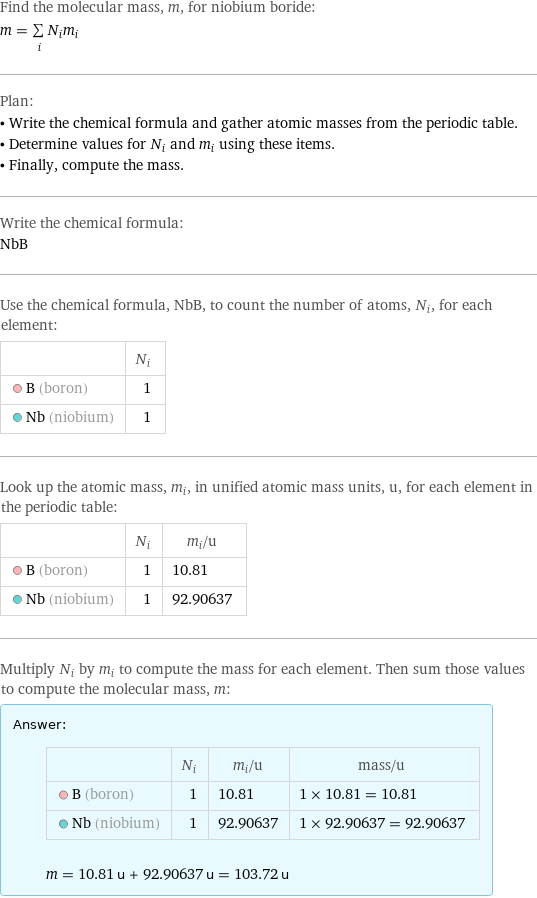Input interpretation

niobium boride | molecular mass
Result

Find the molecular mass, m, for niobium boride: m = sum _iN_im_i Plan: • Write the chemical formula and gather atomic masses from the periodic table. • Determine values for N_i and m_i using these items. • Finally, compute the mass. Write the chemical formula: NbB Use the chemical formula, NbB, to count the number of atoms, N_i, for each element: | N_i B (boron) | 1 Nb (niobium) | 1 Look up the atomic mass, m_i, in unified atomic mass units, u, for each element in the periodic table: | N_i | m_i/u B (boron) | 1 | 10.81 Nb (niobium) | 1 | 92.90637 Multiply N_i by m_i to compute the mass for each element. Then sum those values to compute the molecular mass, m: Answer: | | | N_i | m_i/u | mass/u B (boron) | 1 | 10.81 | 1 × 10.81 = 10.81 Nb (niobium) | 1 | 92.90637 | 1 × 92.90637 = 92.90637 m = 10.81 u + 92.90637 u = 103.72 u
Unit conversions

103.72 Da (daltons)

0.10372 kDa (kilodaltons)

1.7223×10^-22 grams

1.7223×10^-25 kg (kilograms)

103.72 chemical atomic mass units (unit officially deprecated)

103.75 physical atomic mass units (unit officially deprecated)
Comparisons as mass of molecule

≈ ( 0.14 ≈ 1/7 ) × molecular mass of fullerene ( ≈ 721 u )

≈ 0.53 × molecular mass of caffeine ( ≈ 194 u )

≈ 1.8 × molecular mass of sodium chloride ( ≈ 58 u )
Corresponding quantities

Relative atomic mass A_r from A_r = m_aN_A/M_u: | 104

Molar mass M from M = m_aN_A: | 104 g/mol (grams per mole)

Relative molecular mass M_r from M_r = m_mN_A/M_u: | 104

Molar mass M from M = m_mN_A: | 104 g/mol (grams per mole)